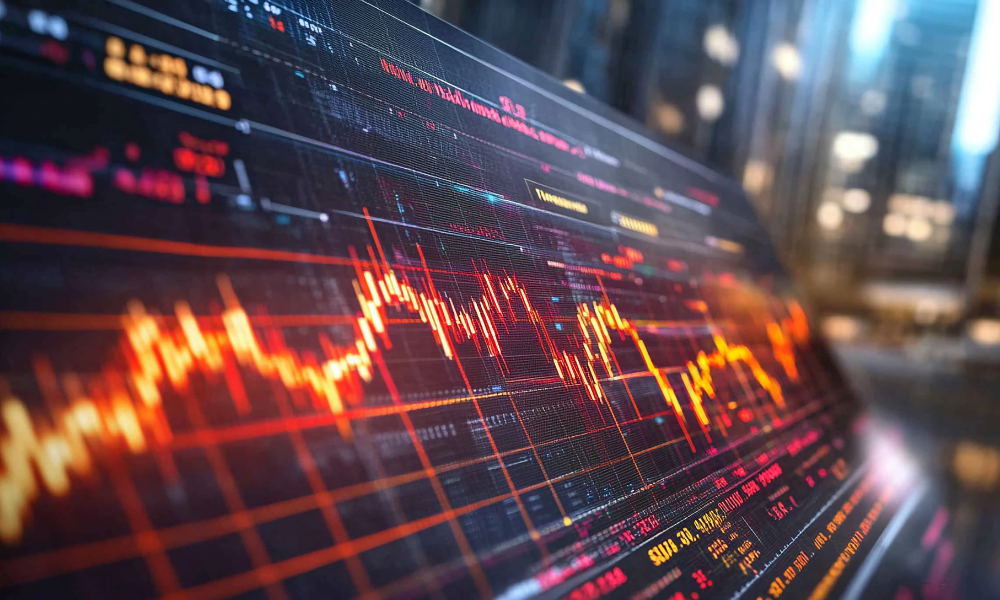

by Ruth Carson and Masaki Kondo
US short-end bonds slumped on concern US President Donald Trump’s move to unleash tariffs on top trading partners will fuel inflation and hurt economic growth.
The risk of a tit-for-tat trade war led traders to boost bets the Federal Reserve will be more careful on lowering interest rates, causing short-end yields to rise faster than longer ones. The moves led the Treasury yield curve to flatten the most in 11 weeks.
Trump made good on his threat to impose levies on the exports of Canada, Mexico and China, while reiterating a warning to the European Union that tariffs “will definitely happen.” Firms including DBS Bank Ltd. and SMBC Nikko Securities Inc. said this puts the world’s largest economy at risk of falling into stagflation.
“A widening of the tariff war would raise the specter of stagflation,” leading to a flatter Treasury yield curve in the process, said Eugene Leow, a senior rates strategist at DBS in Singapore. “If risk-off worsens, there should be downward pressure on 10-year yields.”
Yields on benchmark two-year Treasuries rose seven basis points to 4.27%, while those on the 10-year were steady at around 4.53% amid investor concern over US growth prospects. The gap between the two shrank the most since Nov. 14 on an intraday basis.
Euro-area bonds diverged sharply with US peers, rallying amid a broad flight-to-safety. The two-year German yield dropped eight basis points to 2.05%, opening up the gap with the equivalent US yield to more than 220 basis points — the widest since late December.
“In terms of the strategic implications of this dramatic opening salvo on the trade war front, we would be firmly biased in favor of a wider Atlantic spread,” Rabobank strategists wrote in a note. They recommend positioning for that move via shorter-dated tenors given longer-dated Treasuries may gain on the view that trade frictions will weigh on future US growth.
US overnight-indexed swaps reflected about a 50% chance of two Fed rate cuts this year, down from 90% on Friday. The Fed last week left policy unchanged as it waited to see progress on inflation following a string of rate reductions last year. Data on Friday showed that the central bank’s preferred measure of underlying inflation remained muted in December and that real disposable income barely rose.
“As the risk of stagflation rises, it’s highly likely that US long-term yields will come under downward pressure,” Makoto Noji, chief foreign-exchange and foreign bond strategist at SMBC Nikko, wrote in a note. He added a further increase in the cost of living is expected to result in an economic slowdown.
Traders also preparing for the first Treasury refunding announcement under the Trump administration on Wednesday.
Copyright Bloomberg News

Driven by robust transaction activity amid market turbulence and increased focus on billion-dollar plus targets, Echelon Partners expects another all-time high in 2025.

The looming threat of federal funding cuts to state and local governments has lawmakers weighing a levy that was phased out in 1981.

The fintech firms' new tools and integrations address pain points in overseeing investment lineups, account monitoring, and more.

Canadian stocks are on a roll in 2025 as the country prepares to name a new Prime Minister.

Carson is expanding one of its relationships in Florida while Lido Advisors adds an $870 million practice in Silicon Valley.
RIAs face rising regulatory pressure in 2025. Forward-looking firms are responding with embedded technology, not more paperwork.
As inheritances are set to reshape client portfolios and next-gen heirs demand digital-first experiences, firms are retooling their wealth tech stacks and succession models in real time.
